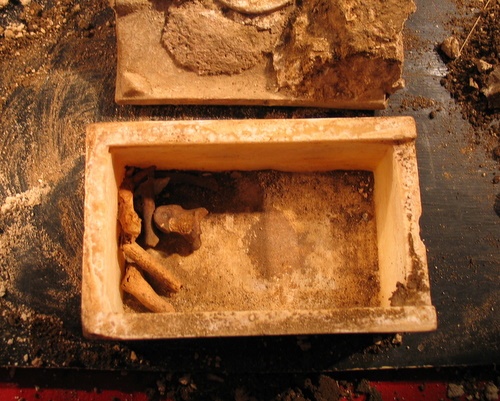June 15, 2012 By Thomas L. McDonald from http://www.patheos.com/
 Two years ago, in an altar in the ruins of a 5th century monastery on Sveti Ivan Island the Black Sea, Bulgarian archaeologists found a small reliquary made of hardened volcanic ash. The Greek inscription on the reliquary included the name of John the Baptist and the date of his birth, June 24th. Scientists naturally dismissed the claims, because scientists all know that Catholic relics are completely fake. They read it … somewhere. They don’t know where. They’ll get back to you on that one. (It’s just like the “fact” that, if you put all the relics of the true cross together, you’d have enough wood to build Noah’s Ark, which is just a plain old lie. You wouldn’t even have enough wood to make a baseball bat.) In any case, the pieces of bone they discovered–a tooth, a knuckle bone, and pieces of a skull, jaw, and arm–have been tested and, whaddayaknow, they come from a 1st century guy who lived in the Middle East:
Two years ago, in an altar in the ruins of a 5th century monastery on Sveti Ivan Island the Black Sea, Bulgarian archaeologists found a small reliquary made of hardened volcanic ash. The Greek inscription on the reliquary included the name of John the Baptist and the date of his birth, June 24th. Scientists naturally dismissed the claims, because scientists all know that Catholic relics are completely fake. They read it … somewhere. They don’t know where. They’ll get back to you on that one. (It’s just like the “fact” that, if you put all the relics of the true cross together, you’d have enough wood to build Noah’s Ark, which is just a plain old lie. You wouldn’t even have enough wood to make a baseball bat.) In any case, the pieces of bone they discovered–a tooth, a knuckle bone, and pieces of a skull, jaw, and arm–have been tested and, whaddayaknow, they come from a 1st century guy who lived in the Middle East:
Many sites around the world claim to hold relics of the saint, including the Grand Mosque in Damascus which says it has his head. Countries around the Mediterranean claiming to have remains include Turkey, Greece, Italy and Egypt. The right hand with which the prophet allegedly baptised Jesus in the River Jordan is also claimed to be held by several entities, including a Serbian Orthodox monastery in Montenegro. “We were surprised when the radiocarbon dating produced this very early age,” said Oxford Professor Tom Higham, who led the study. “We had suspected that the bones may have been more recent than this, perhaps from the third or fourth centuries. “The result from the metacarpal hand bone is clearly consistent with someone who lived in the early first century AD,” He added: “Whether that person is John the Baptist is a question that we cannot yet definitely answer and probably never will.” Dr Hannes Schroeder, from the University of Copenhagen, added: “Of course, this does not prove that these were the remains of John the Baptist but nor does it refute that theory.” Thanks for that scrupulous bit of waffling, Hannes. I don’t wanna be all non-scientificy, but if I have bones in a box labelled “John the Baptist,” and those bones were treated with reverence and date to the early first century, with DNA confirming a person of Middle Eastern origin, then, yeah: those are probably authentic. Here, I’ll even make it sound all official: “I am 92.3% certain these are the real deal.” Let the veneration continue!
